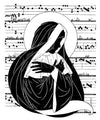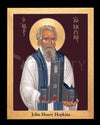Mary in the Qur'an
Mary is a celebrated figure in the Qur'an, both as the mother of Jesus and as the equal of the male prophets who are found in its pages. Mary is the single most prominent female character in the Qur'an, defending her virtue against slander and confronting her lonely and difficult childbirth with bravery and piety (Q 19:16-33). The Qur'an indicates her importance both by its portrayal of Mary as courageous and upright ”the equal of her male prophetic peers” and by noting her membership in the holy lineage of the family of Imran.
The story of Mary is told in greatest detail in two chapters in the Qur'an, sura 19, which bears her name (Surat Maryam), and sura 3, which bears the name of her family (Surat Al Imran). The sura 19 story begins with her secluding herself in a "place in the east" where she is visited by the spirit of God, who announces the birth of a "pure son"(verse 19). The eastern location is the Jerusalem temple; other passages of the Qur'an imagine Mary living in seclusion there in her youth. When she finds herself pregnant, Mary withdraws to another place, where she gives birth to Jesus.
In the parallel narrative in sura 3, Mary is presented as the daughter of a man named Imran, who consecrates her to God and entrusts her for safekeeping to their kinsman Zechariah. Both Mary and Zechariah are portrayed as dwelling in a mihrab, a place of prayer; here God supplies Mary with her every need and announces the birth of Zechariah's son, who will become John the Baptist (verses 35-41). The similarities between this account and the parallel story in Luke 1 suggest that this mihrab was the Jerusalem Temple. In an extraordinary shift, the Quran connects not only Zechariah's a priest in the Bible and a prophet in the Qur'an's but also Mary to the temple on account of their holiness.
This noteworthy change has to do with the Qur'an's perspective on certain important familial relationships. The Mary narrative in sura 3 begins with an announcement that God has chosen certain people's Adam, Noah, the family of Abraham, and the family of Imran's over all others (verses 33-34). The family of Imran includes not only such prominent prophetic figures as Imran, his daughter Mary, her son Jesus, and her kinsmen Zechariah and John, but also their ancient Israelite ancestors Imran's namesake Amram and his famous sons Moses and Aaron. The story thus establishes Jesus'™ place in a genealogy traced back not to David through his father Joseph, as in the Gospels of Matthew and Luke, but rather to Moses and Aaron through his mother Mary.
This explains a puzzling reference to Mary as ukht Harun, sister of Aaron, in Q 19:28, in the midst of one of the main narratives of Jesus'™ birth. Western scholars have sometimes addressed this seeming mistake by noting that it most likely stems from a confusion of Mary with Miriam, the sister of Moses and Aaron in the Bible. However, Islamic tradition defends the Qur'an's accuracy by observing that the term sister's here means "kinswoman." This is not mere apologetics, but rather a perceptive reading of the Qur'an's implication that Mary has inherited the holiness of Aaron, the first high priest in the Bible. Shared sanctity links the members of the family of Imran, whether through the (exclusively male) priestly purity of Aaron or the moral purity achieved by Mary.
-by Michael Pregill




















